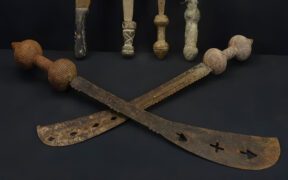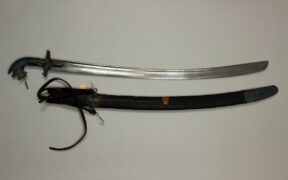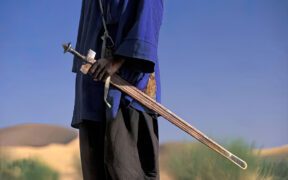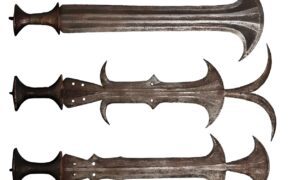Our content features commercial links to our products, committed to transparent, unbiased, and informed editorial recommendations. Learn More
Kaskara Swords: Unveiling Sudan’s Storied Blades and Battlefield Prowess
NO AI USED This Article has been written and edited by our team with no help of the AI
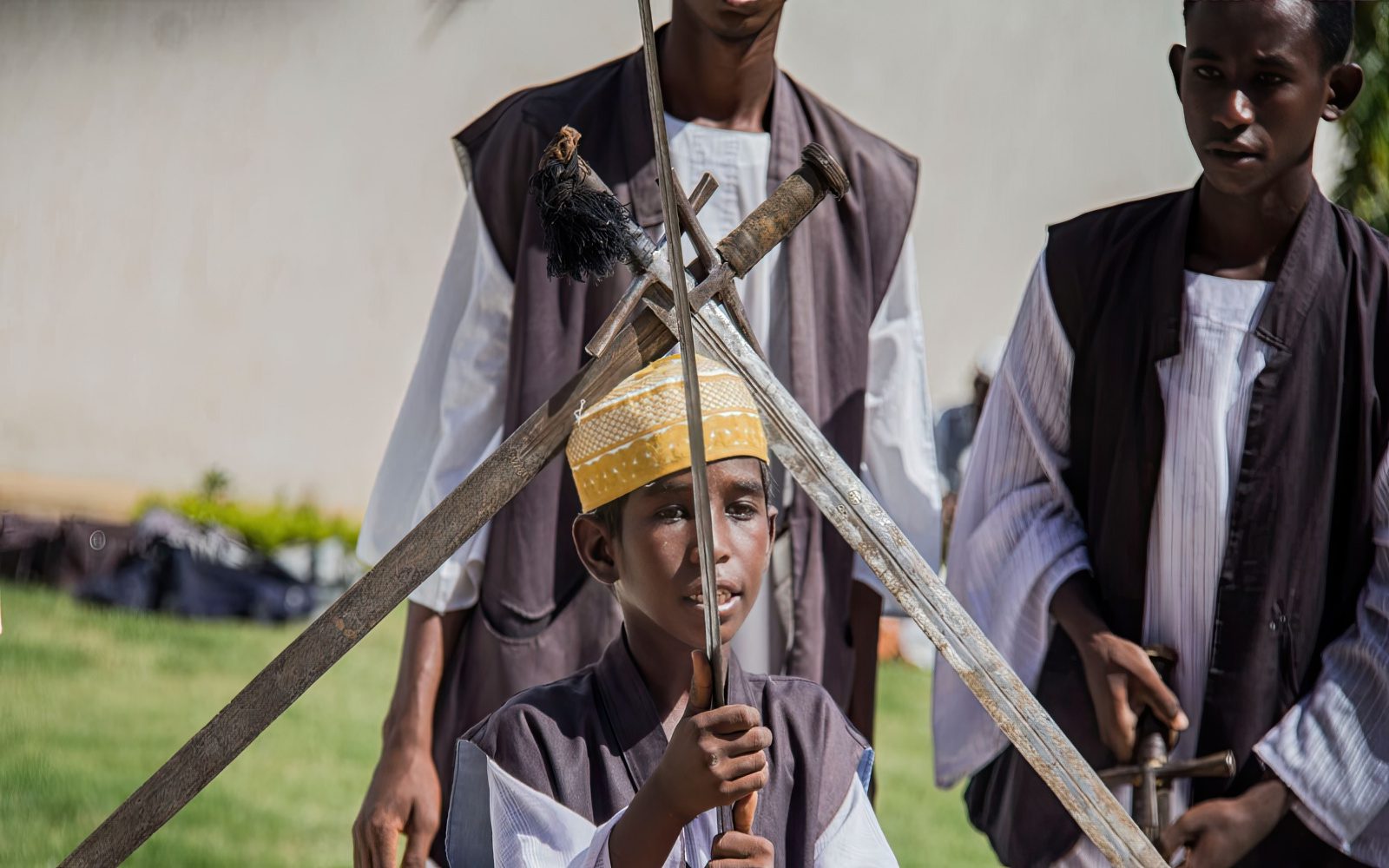
Some African swords are commonly mistaken as European due to their design and characteristics. One such blade is the Kaskara Sword, a bladed-edged weapon from the regions of modern Sudan. It does not feature exotic traits like many other African swords, but it was deadlier in battle.
The Kaskara Sword was an essential item worn by men for many centuries in North and East Africa as part of a traditional outfit and a weapon for self-defense. This article will review the different types of Kaskara blades and their characteristics. Then we will explain how these traits were best used and discuss the sword’s history.
Types of Kaskara Swords
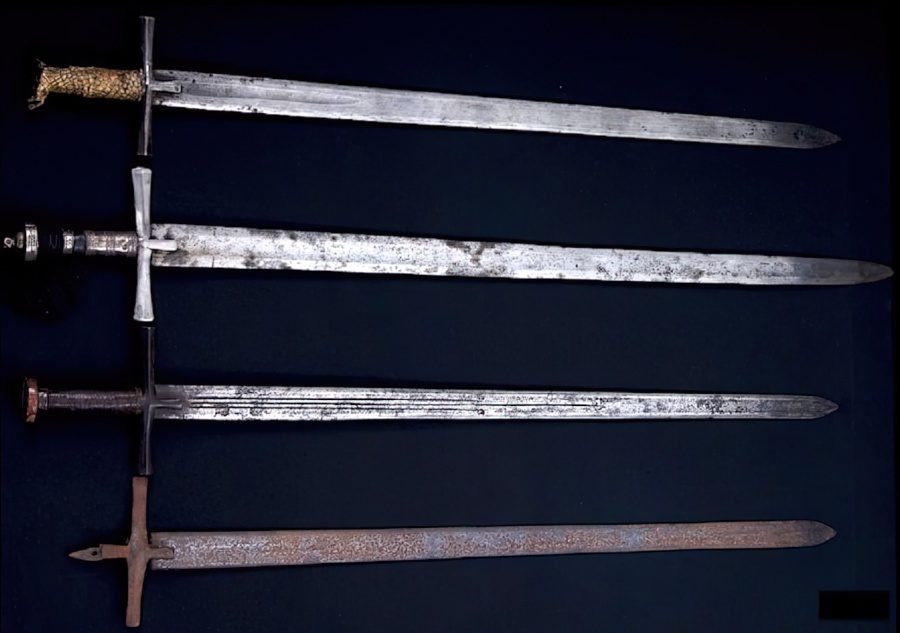
African Sudanese Kaskara Swords can be split into three categories, all sharing the same hilt and scabbard features, with the main difference being the fullers on the blades. The terminology of these swords is in Sudanese as they have split them into these groups based on the type of steel imported and how many fullers it features.
Sulimani Kaskara
The Sulimani Kaskara blades have two to four fullers, common for European blades from the late Middle Ages. Kaskaras are most often brought back from Europe and seen in museums today.
El Kar Kaskara
El Kar Kaskara blades have only one wide fuller in the middle of the blade that looks thicker at the neck and gets less noticeable as it moves toward the tip. It is most often found on Ethiopian Swords.
Dukkeri Kaskara
The Dukkeri Kaskara sword is the oldest Kaskara blade imported from Europe, possibly dating to a design from the 13th or 14th century. It is a very common Kaskara Sword today, and most have German or other European manufacturing designs and symbols engraved on their blades.
Characteristics of the Kaskara Sword
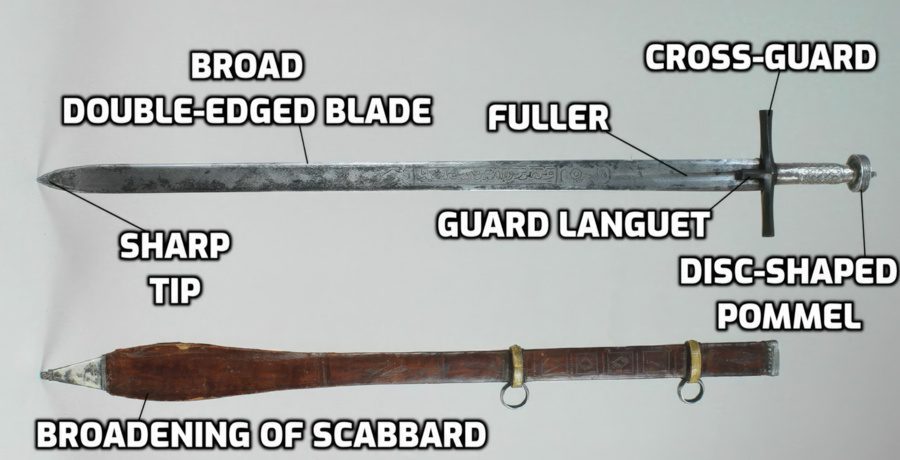
The Kaskara Sword is an African Sword often mistaken for a European blade, primarily because of the cross guard with the smaller languet that people often associate with the Knights Templar. It has unique characteristics inspired by European medieval and Eastern Arabic swords.
Blade
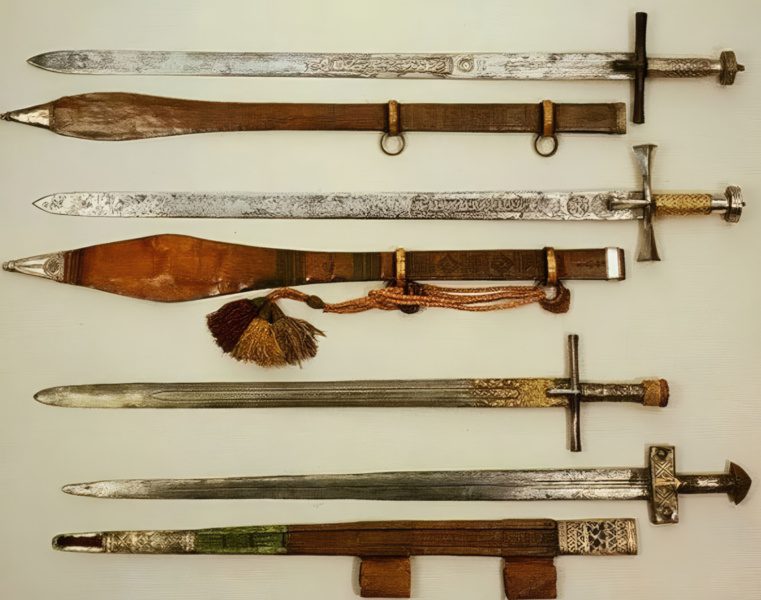
The blade of the African Kaskara Sword is straight and double-edged, meaning sharpened on each side. The blade edges are commonly parallel until the end of the tip, but sometimes it can start tapering at the second half of the blade. The usual blade length for the Kaskara Sword is around 27 to 35 inches (70 to 90 cm).
It can be made of iron, but most of the swords found are made of steel. Some are created locally, while some blades can be imported by European manufacturers, especially during the start of colonialism. Most Kaskara blades feature a single and wide fuller, while in rare cases, there are three smaller grooves, as seen on the Espada Ancha sword.
If imported, some Kaskara blades would feature European manufacturing marks. Some, however, can have decorative designs and feature Arabic Islamic inscriptions or traditional African symbols for authority and prosperity.
Guard
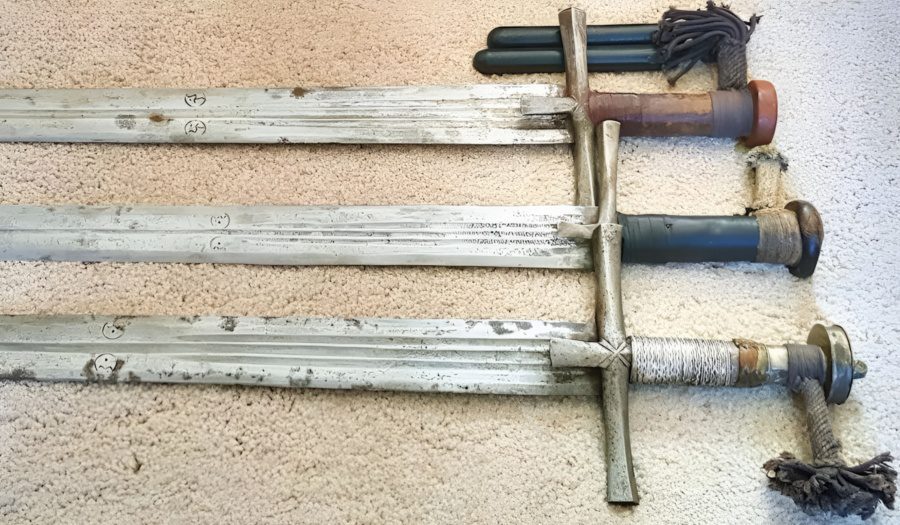
Kaskara Swords have a metal crossguard resembling a cruciform, a typical European blade design. Two quillons are straight and extend from the guard to each side. The most striking feature of the Kaskara guard is the single or double langet that comes onto the blade itself. While created for aesthetic reasons, this is used for protection, offers a more versatile grip, and acts as a blade catcher.
From about 150 years ago, this design has led people to believe that the sword is an authentic Templar or Crusader Sword. Although this is incorrect, there are still some cases where the Kaskara is marketed as such on the internet. This marketing term is false because many Islamic warriors fought back against the Crusaders with cross-hilted swords, a fact not well known today.
Handle

Kaskara Swords have a straight one-handed handle usually made of wood wrapped in leather covering the full-tang blade underneath it. Most Kaskara handles are simple, and round and do not broaden toward the blade or pommel. The most usual length for the handle is around 6 inches (15 cm) which is ideal for one-handed or two-handed use.
In some cases, the handle is heavily decorated, especially for swords belonging to nobles or people of rank. These handles can be wrapped with crocodile or lizard skins, silver, and precious metals.
Pommel
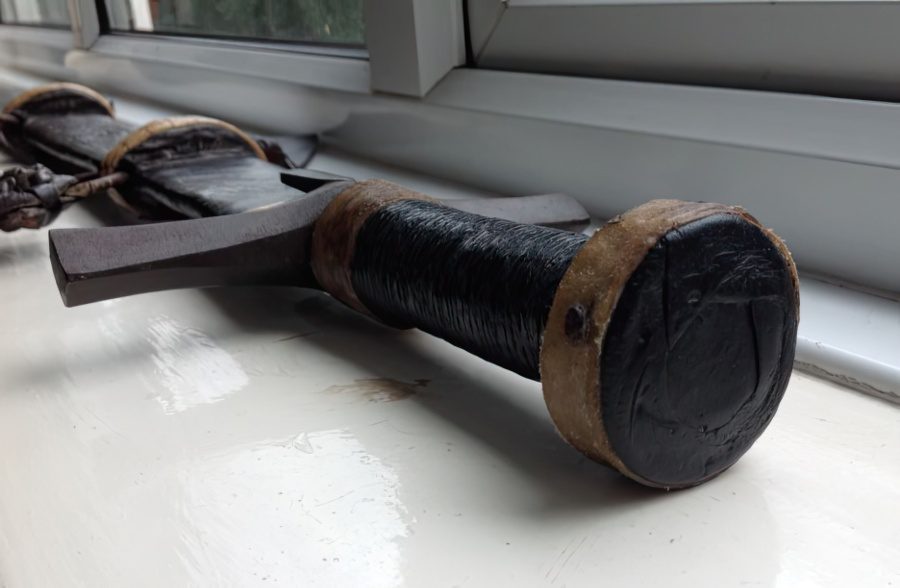
The Kaskara pommel is round and usually in the shape of a disc. It can be made of wood but is usually made of metal, acting as a counterweight to the blade. The pommel is also an effective bashing tool during close-quarter combat. Sometimes the pommel can be wrapped with the same leather as the handle, holding the end of the full tang blade together.
The pommel of the Kaskara usually has a traditional Sudanese tassel tied around it which can be made of wood for decorative reasons. Sometimes leather is meant to go around the user’s hand for better stability when wielding the sword.
Scabbard
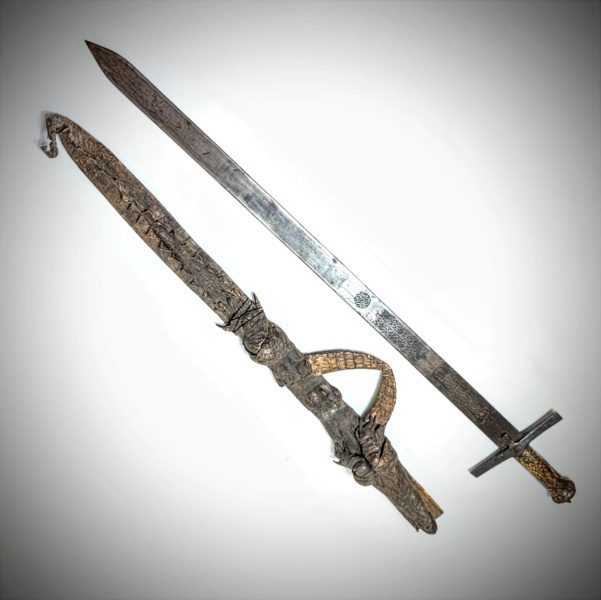
Kaskara scabbards are placeholders for the blade when the sword is not in use, protecting the weapon against natural elements and corrosion. An interesting characteristic of the scabbard is the broadening or leaf-shaped end. This is fairly common on African swords, such as the Manding sword, and can be made to resemble a python or crocodile, which were both revered in many traditional African cultures.
Some Arabic Kaskara blades have straight scabbards made of colored leather in different variations. Some scabbards can have decorations made with lizard, crocodile, snake, or other reptile skin. Kaskara scabbards are worn with a leather cord that goes over the shoulder, and the sword is kept horizontally with the blade pointing forward under the chest.
Weight

The Kaskara Sudanese African Sword is a one-handed weapon that could have been used on foot or mounted. Due to its light weight, it was a frequently used bladed-edged steel weapon carried in battle or for daily use. The most common weight for the Kaskara sword is 2.6 lbs (1.2 kg).
Length and Size
African swords generally aren’t very long and were used as secondary tools of war combined with a shield. But the Kaskara was longer and could be used as a primary combat tool with or without a shield due to its size. The most typical Kaskara sword length is between 35 and 43 inches (90 to 110 cm).
Uses for the Kaskara Sword
African Kaskara Swords are one-handed weapons primarily used for hacking, chopping, and slashing. Some taper gradually from the blade’s mid-point forward and could also be used for thrusting. Usually, the Kaskara was used in conjunction with a shield or from a mounted position.
Warfare and Combat
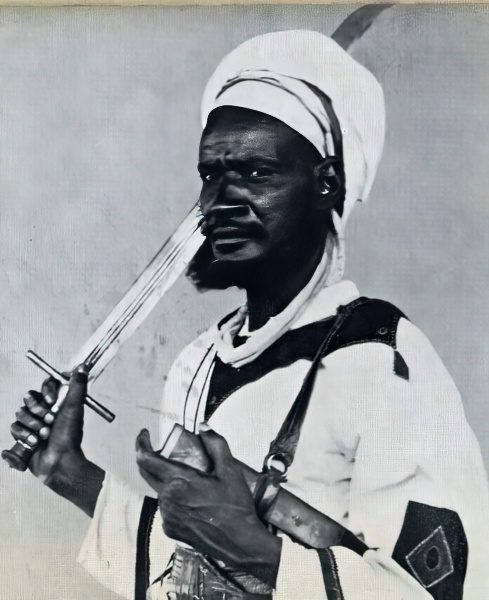
While most African swords can be labeled as war and combat swords, the Kaskara was the choice weapon in most cases. It was frequently bought and used in most wars in Eastern and Northern Africa. While a ceremonial African sword was worn on one’s side, the combat Kaskara was almost always carried to battle, primarily used with a leather buckler shield.
Because of its simple yet effective design, the Kaskara is one of the most popular African swords used. There are many instances where Kaskara blades had much significance in the outcome of a battle.
Ceremony and Prestige
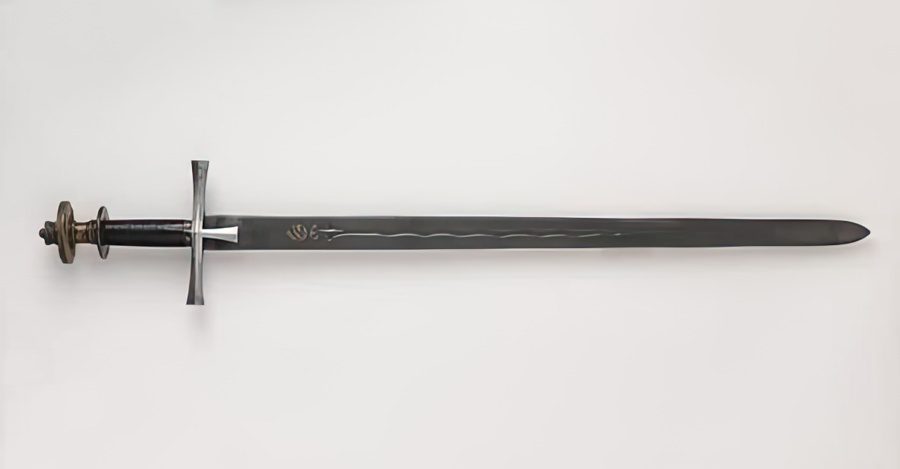
The Kaskara can be seen alongside Sudanese nobles and Arabic traders. Because of its effectiveness in battle, its power and status were very high. Often it was linked with the most powerful warriors in battle while others used only spears. Owning one was considered prestigious and it was also used in various ceremonies such as weddings, meetings, and diplomatic events.
Martial Arts and Traditional Dance
The Kaskara is one of the most studied African swords today. It is a common training piece in modern HAMA (historical African martial arts) events. It is a blade that’s still very much part of the traditions and customs in the rural areas of modern-day Sudan and Chad. For example, in the Darfur region, the Kaskara is still part of men’s traditional costumes. Many sword dances still exist that stylize and feature the combat methods of the Kaskara sword.
History of the Kaskara Sword
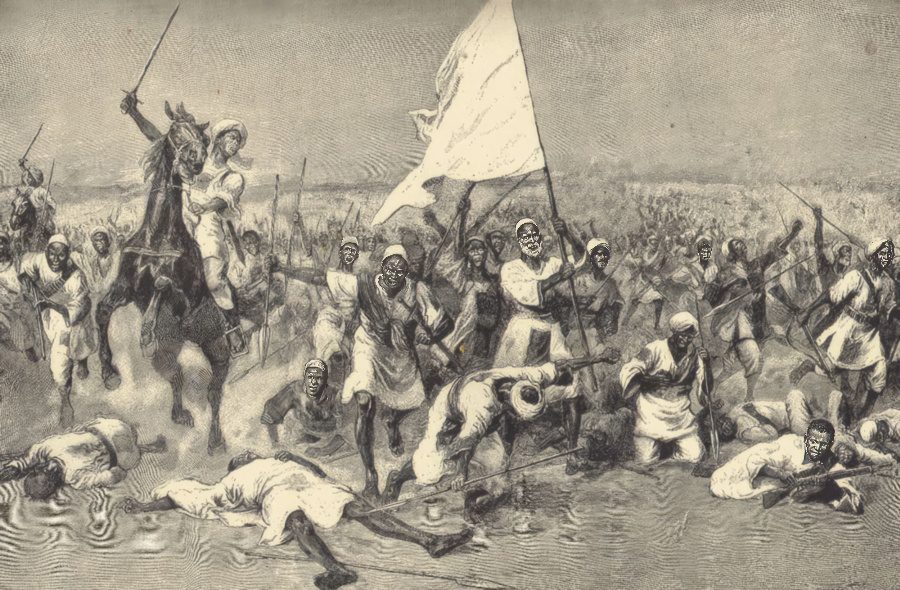
The Kaskara Sword is an African blade from the regions of Sudan, Eritrea, and Chad. The sword is thought to have been developed around the 16th century, but its prototype could have been as early as the 14th century. The swords were based on the straight, double-edged Arabic swords of the Middle Ages that may have influenced Sudanese swordsmiths. Some believe that the Kaskara could have been traded by the Crusader states as far back as the 11th century.
The Kaskara was a warfare and combat type of sword. It was both a prized possession used in trade and ceremonies, but the Kaskara was truly a weapon of war. According to some historical travelers, it was the most essential possession for African men, as the Arming Sword, Longsword, or Hanger Swords were in Europe.
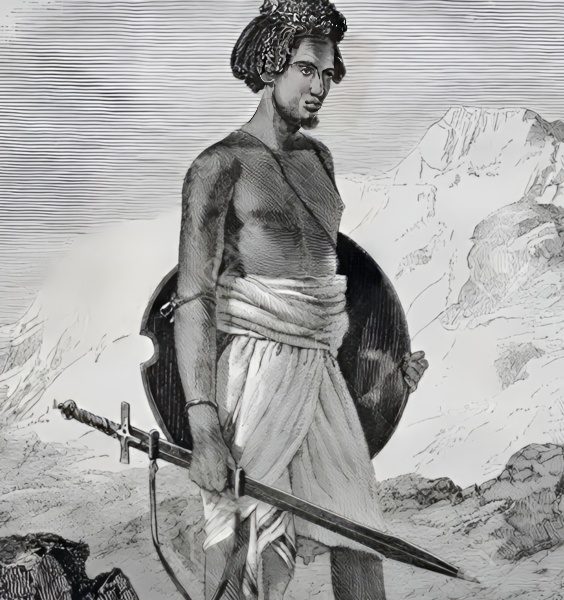
From the 15th century, the European imported blades became very popular across Africa. They were used for similar swords to the Kaskara, such as the Takouba, whose main difference is the tapering blade from the very broad guard. In Sudan, Kaskaras were made with local and imported European blades in the well-known artisan center of al-Fashir.
It was a primary sword to use both mounted and on foot and mounted aside from spears and rifles in the late 19th century. It is believed that the Battle of Gallabat with Ethiopia in 1889 was the last large battle where the Kaskara was the primary weapon of war. It’s popularity today is because it was seen and described by those during the British conquest and battles in the Omdurman period of 1898.
